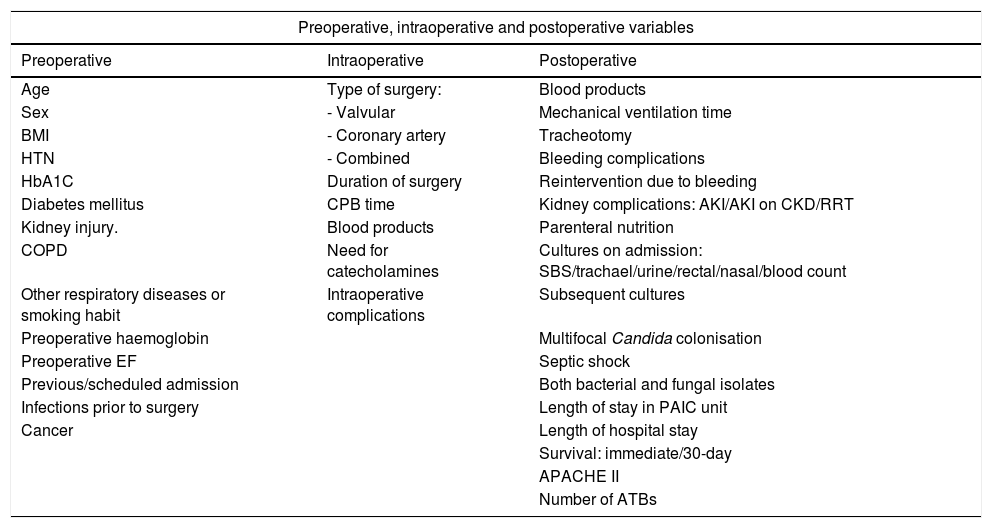Patients undergoing cardiac surgery can have post-operative complications, including infections. The aim of this article was to study the incidence, severity and risk factors of invasive candidiasis in these patients, based on the hypothesis that several factors (multiple transfusions and time on extracorporeal circulation) are related to invasive candidiasis.
Material and methodsThe study included a prospective analysis of 669 patients undergoing scheduled cardiac surgery from April 2016 to December 2017. Control cultures were collected on admittance to the Surgical Intensive Care Unit.
ResultsThe incidence of invasive candidiasis was 2.69%, being confirmed in 1.79% of cases. The most frequently isolated Candida species was Candida auris. Mortality rate in the invasive candidiasis group was 11% in the immediate post-operative period and 22% at 30 days. After the univariate study, a statistically significant relationship was found between invasive candidiasis and multiple transfusions (OR 15.86; 95% CI: 5.15–69.4; p<0.001). A statistically significant relationship was also found with other known risk factors in hospitalised patients.
ConclusionsMultiple transfusions are associated with an increased risk of invasive candidiasis. Surveillance measures for fungal infection in patients with risk factors undergoing cardiac surgery should be implemented in hospitals with a high incidence of candidiasis.
Los pacientes operados de cirugía cardiaca presentan numerosas complicaciones postoperatorias, entre ellas, infecciosas. El objetivo de este estudio es investigar la incidencia, gravedad y factores de riesgo de candidiasis invasiva en estos pacientes, partiendo de la hipótesis de que factores como la politransfusión y los tiempos prolongados de circulación extracorpórea están relacionados con ella.
Material y métodosSe analizó prospectivamente a 669 pacientes operados de cirugía cardiaca programada desde abril de 2016 hasta diciembre de 2017. Se procedió a la extracción de cultivos de vigilancia al ingreso en la Unidad de Cuidados Intensivos de Anestesia, así como cultivos posteriores.
ResultadosLa incidencia de candidiasis invasiva fue del 2,69%, confirmada en el 1,79% de los casos. La especie de Candida más frecuentemente aislada fue Candida auris. La mortalidad en el postoperatorio inmediato fue del 11% en la candidiasis invasiva, que aumentó al 22% al mes de ingreso. Tras el estudio univariable se encontró una relación estadísticamente significativa entre la candidiasis invasiva y la politransfusión (OR 15,86; IC %: 5,15-69,14; p <0,001). Asimismo, también se encontró una relación estadísticamente significativa con otros factores de riesgo conocidos en pacientes hospitalizados.
ConclusionesLa politransfusión se asocia a un mayor riesgo de candidiasis invasiva. Es necesario implementar medidas de vigilancia para la infección fúngica en pacientes con factores de riesgo que vayan a ser operados mediante cirugía cardiaca en hospitales con elevada incidencia de candidiasis.










